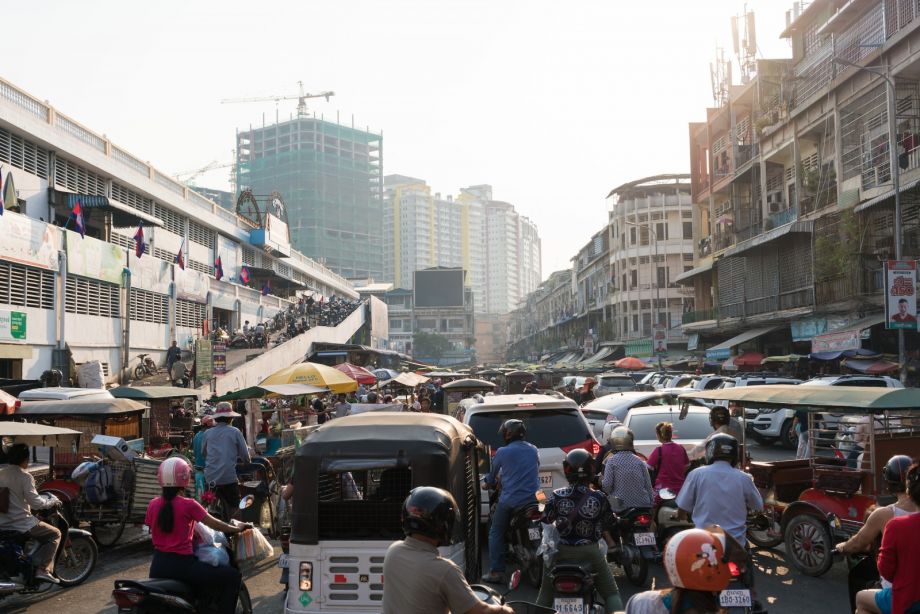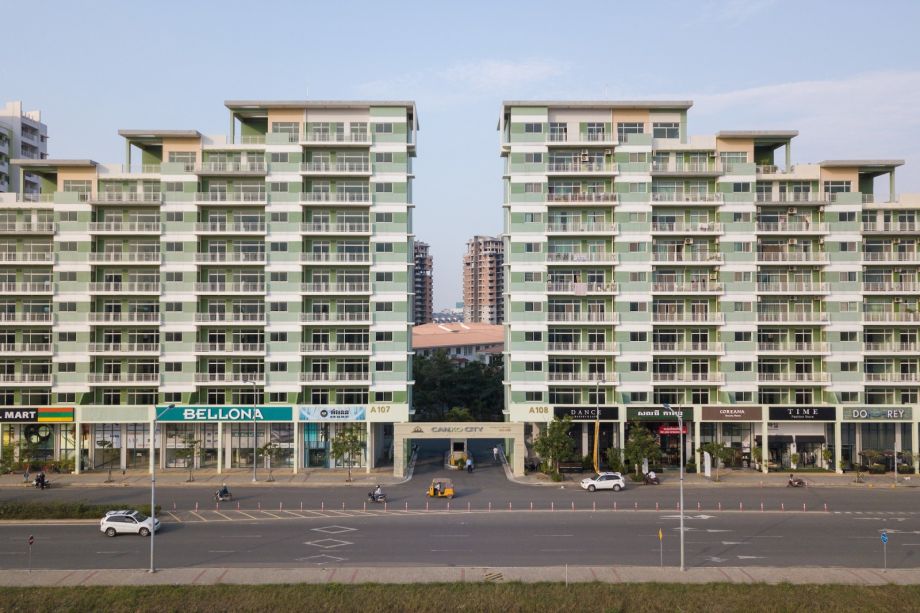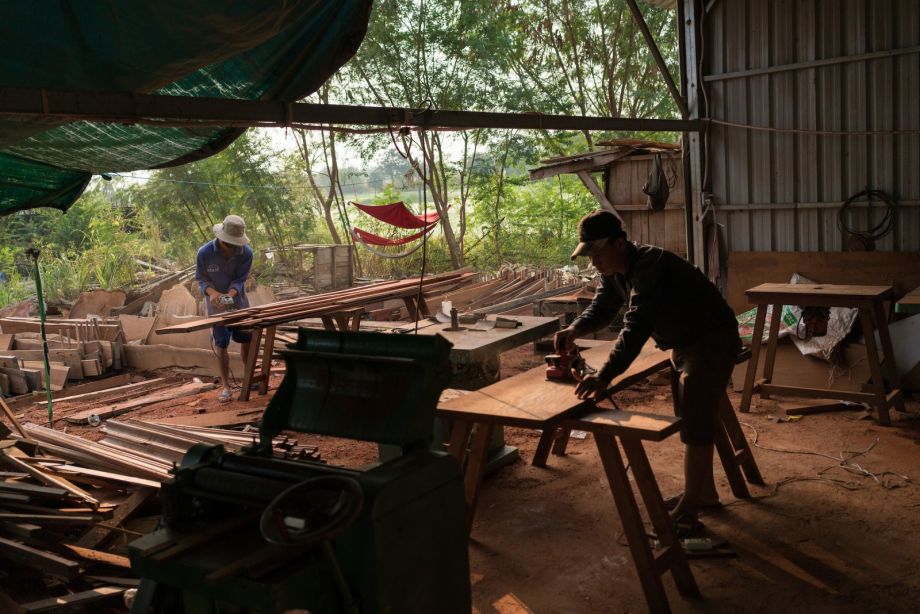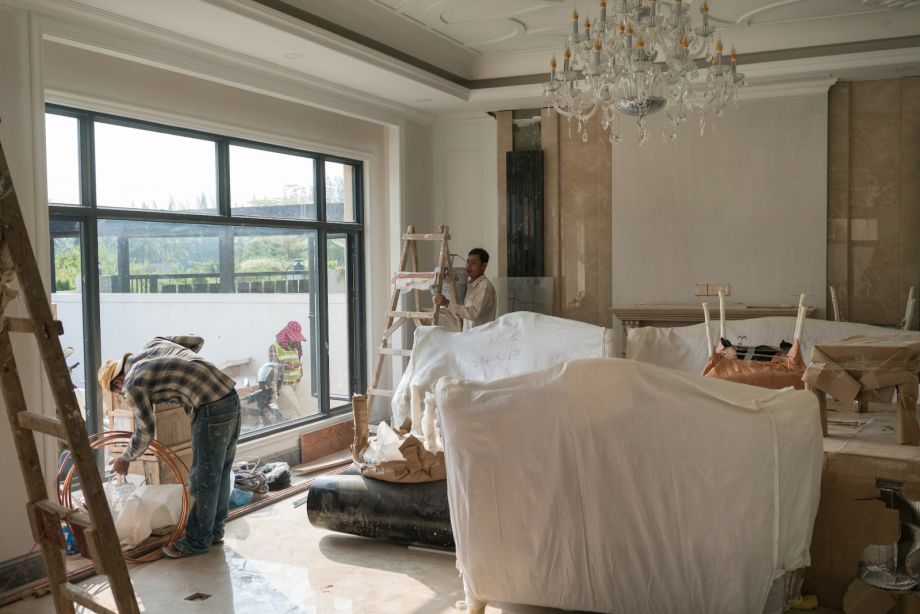Are You A Vanguard? Applications Now Open
Aerial view of the gate of the Grand Phnom Penh International City.
This is your first of three free stories this month. Become a free or sustaining member to read unlimited articles, webinars and ebooks.
Become A MemberThis week, planners, policymakers and urban practitioners from across the world are gathering in Kuala Lumpur for World Urban Forum 9. This story is part of Next City’s coverage of the Forum. For more stories, visit our World Urban Forum 9 page here.
At the entrance to Grand Phnom Penh International City, bronze stallions gallop across the tops of twin arches, supported by imposing white columns in the classical style of ancient Rome. The road that leads into the luxury estates beyond is lined with coconut palms, a rare nod to Cambodia in this satellite city that feels a world away from its geographic location.
Situated on 640 acres of land to the north of Phnom Penh, the “self-sustaining urban township” is being built as a joint real estate venture by Indonesian and Cambodian property developers. It is one of a half-dozen massive development projects — entire cities and neighborhoods unto themselves — reshaping the character of Cambodia’s dusty, low-rise capital.
For the past two decades, the Cambodian government has been handing over large tracts of land to private companies, ostensibly with the aim of spurring economic development. But what was initially designed to be a selectively-employed tactic to attract foreign investment has evolved into a broad-based approach to urbanization that concedes large sections of the city to offshore property developers.
Economic Land Concessions (ELCs), as such land deals are usually called, were until recently mostly used in rural areas. The government would grant a foreign agricultural company a long-term land lease and in return that company would use the land to grow crops like bananas or sugarcane. The concept was framed as a win-win scenario, in which private companies get access to land and Cambodia gets an economic boost from a thriving agrobusiness within its own borders.
The model wasn’t without flaws, however. The Cambodian Center for Human Rights estimates that 700,000 Cambodians have been displaced from their homes to make way for ELCs, and that often these agreements have been used as little more than a cover for illegal logging. More and more, the concessions have come to be viewed as a territorial giveaway to rapacious foreign powers, which prompted Cambodia’s prime minister to declare a moratorium on granting new ELCs in 2012.
But the ELC model didn’t die. Over the past decade, as urbanization has become big business, ELCs have migrated from the countryside to the city. Though such land deals in cities are not characterized as ELCs on paper, in reality the practice is much the same: The government awards huge chunks of urban land to offshore investors and local developers alike. Much of this development is taking place in huge development projects owned entirely by private companies on city fringes.
To a degree, these satellite city projects are a response to rapid urbanization and economic growth, combined with a state failure to invest in planning and infrastructure — this is what has happened in Phnom Penh. According to University of Leeds geographers Tom Percival and Paul Waley, property developers sense an opportunity and step in to fill the void with their model of urban planning by private corporation.
“This caters to a growing demand for satellite city living from middle- and upper-income groups, who are wooed by images of a cosmopolitan lifestyle. Businesses too evince the desire to move out of makeshift space in the city center into the appropriately international setting of a satellite city,” the academics write in Articulating Intra-Asian Urbanism: The Production of Satellite Cities in Phnom Penh. “At the same time, governments have become increasingly entrepreneurial in order to attract investment from regional urban development companies.”

View of the surrounding area of Orussey Market in central Phnom Penh.
Drive down the perfectly paved streets of Grand Phnom Penh, and a sound that has become rare elsewhere in the traffic-snarled city can be heard all around: birds chirping in unison. Residents say that the tranquil environment is what drew both them and the birds. Nhek Sim, a retiree who declined to give her age, bought into Grand Phnom Penh two years ago. She thinks of it as a weekend escape from her home in an affluent suburban area that’s mostly populated by middle-class Cambodians. “I used to have another house in the inner city, but because of the traffic and pollution, I rented it to someone else and went to live in Toul Kork. But now, [the livability there] is not very good either,” she says.
Her two-story townhouse overlooks an 18-hole golf course created by Jack Nicklaus’ design firm, and is a stone’s throw from a theme park, Fantastic Water World. Still in the pipeline for this area are a golf clubhouse, school and shopping mall. According to an on-site sales executive who spoke anonymously, as she is not authorized to comment to the media, prices for the 5,000 homes that are either built or being constructed range from $111,000 to $1 million. By comparison, the minimum monthly wage in Cambodia’s vast garment sector is just $170; many workers in other industries are paid considerably less.
This is not just a Cambodian phenomenon. The trend can be seen across Southeast Asia, where it has become increasingly common over the past decade for satellite cities to spring up in peri-urban areas.
Vietnam is home to several sprawling projects. In Ho Chi Minh City, the Taiwan-backed Phu My Hung, or Saigon South, was originally intended to house a million people. Northwest of Ho Chi Minh City, a Malaysian firm is building the largest project, North West Metropolitan Area, at an estimated cost of $3 billion. In the capital, Hanoi, long-established Indonesian developer Ciputra is constructing Ciputra Hanoi International City on 740 acres in partnership with a local firm.
In Malaysia, Bandar Malaysia is a new planned business district in Kuala Lumpur of which China has been seeking partial ownership. And off the country’s Singapore-facing coast, a string of cities are being built by Chinese companies, with buyers from mainland China as their target market.
Even tiny Laos has seen large-scale foreign property investment. On the outskirts of the capital, Vientiane, is the $1.6 billion That Luang marsh development, a controversial Chinese project that has led to the eviction of hundreds of families.
These satellite cities are generally financed by either a single developer or through a joint venture, and they result in entirely planned settlements that integrate residential, business, retail and leisure amenities into one community. Most of these self-contained urban systems are being built either partially or entirely by foreign firms, each via an ELC-style agreement with the host country or through other government-driven economic development schemes.
Regionally, this model has its roots in Indonesia. It dates back to the early 1970s on the outer edges of Jakarta — then a relative backwater and now a sprawling megacity of about 30 million people — in response to a growing middle-class demand for suitable housing. One of the first privately developed satellite cities, Pondok Indah, broke ground in 1975. Built atop 1,135 acres of former rubber plantations, it has since morphed into a wealthy suburb in the south of the Indonesian capital.

Camko City, a $2 billion urban development project in the north of Phnom Penh.
Indonesia’s early satellite cities were built by domestic companies, but more recent projects across Southeast Asia tend to be funded by foreign direct investment funneled in from other parts of Asia. For example, Indonesia-based Ciputra, which also helped establish Pondok Indah, is the international driving force behind Cambodia’s Grand Phnom Penh.
Satellite cities in the region, Percival and Waley note, are “based on models of urban design and governance practices in other Asian cities, or they utilize best practice examples, which are extracted and emulated from other cities … The mobility of capital, concepts and expertise has been and remains central to the process of diffusion of these urban projects throughout Southeast Asia.”
Yet despite this cross-border flow of investment and expertise, the attributes typical of many Southeast Asian cities are not immediately obvious to a visitor at these developments. There are no chaotic markets overflowing with fruit and vegetables; no vendors hawking their wares; and no motorbikes or tuk-tuks buzzing around. The streets are orderly and quiet, the identical houses painted in muted hues. These are, as the sales prices suggest, developments that cater to the rich. At Grand Phnom Penh, toy Mercedes-Benzes and Maseratis are parked in front of the model homes. Both here and at nearby development CamKo City, villas are accompanied by Lexus SUVs, the preferred automobile among the Cambodian elite. Many of them bear the distinctive license plates affixed to cars driven by government and military officials, a clue as to who is really benefiting from the country’s development boom.
Simon Springer, an associate professor of geography at the University of Victoria who specializes in Cambodia, says corruption and elitism are inseparable from the mechanisms surrounding large-scale land distribution. “Cambodian politics is still very nepotistic and operates through patron-client relations,” he says. “What’s changed is simply the rapidity of ELCs being granted and the brazenness of officials to assign them. There’s just no shame at all at this stage, and they don’t even attempt to look honorable in how these are being managed because the views and interests of the general public are a complete afterthought, if they’re ever even thought of at all.”
Meanwhile, some analysts question the economic benefits of these developments. Stephen Higgins, the co-founder of investment and advisory firm Mekong Strategic Partners, says that while they function adequately as “dormitory suburbs,” they fail to drive meaningful economic outcomes. “Cities become powerful economic drivers when they attract a large group of diverse economic actors who come together and achieve more than what they could separately,” he says. “That just doesn’t happen with satellite cities.”
CamKo City, a $2 billion project spearheaded by Korean firm World City, was one of the first projects — built on the site of a former lake — to break ground in Phnom Penh back in 2007. The company maintains it purchased Pong Peay lake from private owners, though under Cambodian law, such bodies of water are state property. Construction on the sprawling 250-acre site ground to a halt amid the 2008 financial crisis, which derailed Korea’s financial sector and led to the collapse of World City’s banking partner, Busan Savings Bank. Seven condominium blocks still stand half-finished, but eight others are filled with residents, and investment planning manager Jung Kuy Shin says World City is pressing ahead with the next phase of development.
Though the master plan will be revised this year and some sections are set to be sold off or developed in partnership with external funders, Shin says World City remains committed to developing the site — and also to the infrastructure pledge the company made to Cambodia’s government.
“All of the infrastructure is being built by our company, and our company is managing all of the infrastructure, including communications, sewage, disposal facilities, drainage, electricity and water,” Shin tells me over a table covered with plans for the development. “We’ve already installed a road here,” he adds, pointing to a diagram of the site.

Laborers at work in an impromptu workshop built outside one of the villas under construction in Grand Phnom Penh International City.
While potential buyers no doubt find this comprehensive provision of services attractive in a city where basic functionality is often lacking, observers say it speaks to one of the problems presented by satellite cities: If an under-resourced government palms off the provision of infrastructure to private developers catering to the rich and influential, who will provide for the city residents, failed by the state, who cannot afford the steep price tag attached to all-inclusive property?
Many agencies are already sounding the alarm on the economic disparities this development model is embedding into urban areas. “Without pushing for comprehensive city infrastructure, Phnom Penh risks seeing development only for the wealthy,” notes the 2017 World Bank report Expanding Opportunities for the Urban Poor. “Currently, these satellite cities are not included in any broader development plan and do not coordinate infrastructure with surrounding neighborhoods.”
Judy Baker, the report’s co-author and lead urban specialist at the World Bank, says the degree of impact on Southeast Asian cities largely depends on how well planned the links are between large-scale development and wider urban structures. This includes “how they are connected to existing transport, water, sewage and other trunk infrastructure to connect people to jobs and opportunities; whether they use sustainable approaches to development; and the extent to which they provide for affordable housing so that they can contribute to balanced and equitable development.”
Every development in Phnom Penh must to adhere to an overarching master plan, regardless of its size, according to municipal spokesman Met Meas Pheakdey. But the document, “Phnom Penh Land Use for 2035” — the first comprehensive master plan since the French colonial era — was only released in 2015, years after all of the large-scale developments currently under construction won government approval.
And since its release, implementation of the master plan has been patchy. One of the biggest challenges is a lack of government oversight, according to the Asian Development Bank, which points out in a 2016 report: “There is no specific ministry for urban development and planning; it is delegated across several ministries.” Responsibility for roads is split between two ministries, and one of these is also concerned with drainage; water resources are under the purview of a third ministry, but the city water authority is charged with supplying water to homes and businesses; and a fourth ministry, that of Land Management, Urban Planning, and Construction, is limited to the spatial aspects of planning.
Little wonder, then, that there is a disconnect between self-contained satellite cities and the urbanscape around them. A spokesman for the ministry in charge of spatial urban planning declined to comment.
Residents either living nearby or who have been evicted from their homes to make way for large-scale developments, unsurprisingly, feel less than enthusiastic about them.
Seang Nat lives about an hour’s drive from his old home in the center of Phnom Penh, from which he was evicted in 2008 to make way for the city’s most contentious foreign-backed development to date: the Boeung Kak lake project. In early 2007, the municipality handed over 330 acres of prime land — including the 222-acre publicly owned lake — to local development firm Shukaku, a decision that would result in a 10-year battle with local residents who were unwilling to make way for the luxury development.
Offered the choice of $8,500 compensation, a one-bedroom home on the outskirts of Phnom Penh or the promise of an onsite apartment once construction was complete, many of the 4,000 local families balked. Nat agreed to move his young family to the resettlement site, a decision that still sits uneasily more than a decade later. “At the time, I was worried that if I didn’t move out from the lake area, my house would collapse because of the sand being pumped into the lake,” he says.
Nat says that since then, life has been a struggle for his family. A tuk-tuk driver by trade, finding new clients was a slow burn in the early years, and nowadays he has to compete with the city’s new bus service. Their roof leaks badly and repairs will cost about $1,000 — money the family just doesn’t have. “If my daughter can’t get a scholarship, I’m concerned because I don’t have enough money to send her to university,” he says.

Renovating one of the “premium villas” inside Grand Phnom Penh International City.
Most of the former Boeung Kak residents have moved on from the resettlement site, going either closer to the city or back to their home villages. But Nat’s neighbor, Ly Seth, has also stayed on. Seth is also a driver, though he earns less because he only has a motorcycle. His wife, however, is a well-paid team leader at a nearby garment factory, meaning the family is relatively comfortable and has even added a second story to their home. “Even if one month we don’t have much money, I can just fry up some morning glory, close the door, and eat with my children,” he says.
Regardless, both men complain about the lack of services in the area. “When it rains for a couple of hours, it can flood to knee level inside the house, and after about four or five hours, the water is gone,” says Nat. The roads leading to their homes are rough and potholed, and the smell of sewage emanates from open drains running alongside them. “We plan to make a request to local authorities to build new roads and drainage,” adds Seth.
Developers, however, argue that their projects are helping to address urban infrastructure issues in the long-term. After being stalled for years, the Boeung Kak project is finally under construction and Shukaku is attempting to makeover its toxic image, rebranding the site as the Phnom Penh City Center and offering on its website a vision of a sustainable and innovative community. The company has also shed its Chinese partner in favor of cooperating with a range of local and offshore partners.
Shukaku executive director Michelle Lau, the daughter of a well-connected Cambodian politician who established the firm, says Shukaku hopes to “create a safe, liveable and quality urban environment for the local and international community, where they can live, work and play within the integrated spaces.”
“Given the high population density ratio and rapid urbanization in the older parts of Phnom Penh, where development has outpaced the early infrastructure, it is a prerogative that we take sustainability into consideration when mapping out our master plan,” she says, pointing to PPCC’s infrastructure plans.
World City’s Shin, meanwhile, says that CamKo will begin catering to middle-class Cambodians in future rounds of development. Shin notes that the class is a growing market that has been overlooked in the city’s speculative property boom, so he plans to offer condominiums for less than $80,000. “Our company will try to look at and study the trends and how to help the Cambodian people in Phnom Penh,” he says.
Whether these nods to sustainability and inclusiveness are enough to help address Phnom Penh’s myriad urbanization issues is a matter for debate. Pheakdey Heng, the acting country representative of the Global Green Growth Institute, an international organization that is working with the government on a plan to green the city, says large-scale private developers can help to create jobs, fill infrastructure gaps and even introduce green technology. But, he warns, “They must practice responsible investment by taking into consideration the social and environmental costs and benefits of their investment, not just trying to maximize returns.”
Springer, the geographer, is not convinced. He believes these satellite cities merely “talk the talk of being inclusive, sustainable and equitable.”
“In terms of sustainability, it’s hard for me to imagine how urban sprawl is anything but a scar on the landscape that produces profound damage on existing ecosystems that are simply paved over,” he says. “Developers aren’t concerned with equity or environmental impacts, they simply want to make money and will use whatever strategy works best for them to achieve that. If it means greenwashing in some locations or appealing to elite values in other places, they’ll speak the language that’s going to bring the reward.”
Additional reporting by Chhorn Chansy

Holly Robertson is a freelance journalist based in Cambodia who focuses on human rights, gender and the environment. Her work has been published by The Washington Post, Guardian, BBC, Columbia Journalism Review, VICE and Mashable, among others.

Hailing from the Italian Alps, Thomas Cristofoletti has been working in Southeast Asia as multimedia journalist since 2012. Based in Phnom Penh, Cambodia, he’s also the co-founder of www.ruom.net, a collective of journalists specializing in social reportage throughout Asia. Especially passionate about climate change, Thomas’ long-term projects focuses on the effects of development on the Mekong region and on underreported religious practices around the world. Thomas’ work has been featured in international magazines and newspapers such as The New York Times, Al Jazeera and The Guardian.
.(JavaScript must be enabled to view this email address)

20th Anniversary Solutions of the Year magazine